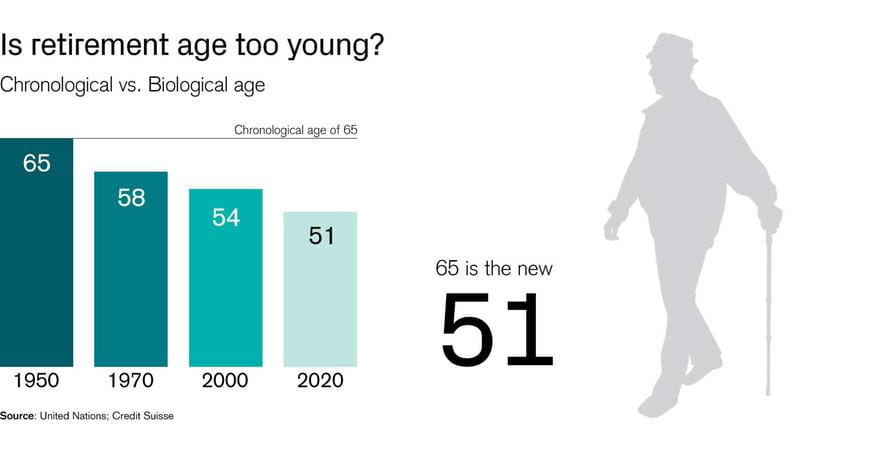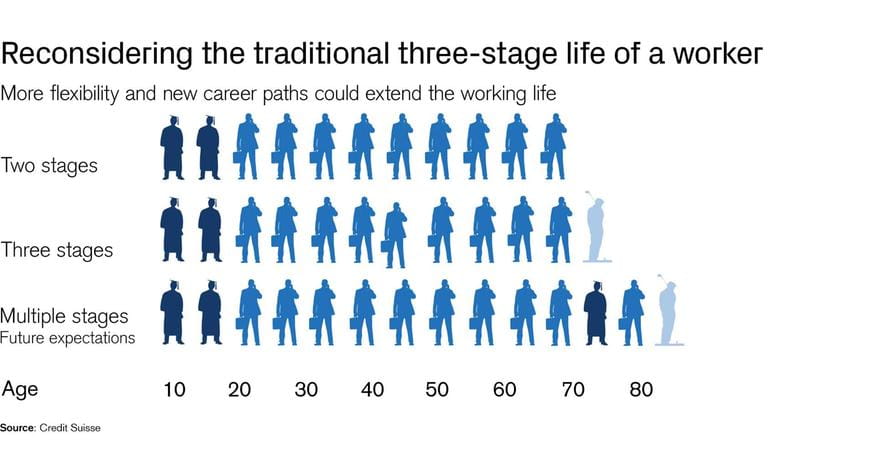The article was originally published by Credit Suisse here. The full study can be accessed here.
A changing world
Both developed and developing countries will face the problems associated with an aging population. The world is undergoing a major demographic transition. Not only are there more elderly people but they are living longer. Average life expectancy has increased globally by 25 years since 1950 from 47 to 72 years today. Advances in the treatment of infectious diseases, improved nutrition and better awareness of the benefits of a healthy lifestyle have all sparked the longevity revolution.
Traditional retirement
In developed countries a person’s life could be typically be divided into 3 stages: education, working career, followed by retirement with a retirement age in your early 60s. People in developing countries more often experienced only two stages; education then work with no expected retirement period, either because of a less secure pension system or because they could not afford to retire.
As fertility rates decline pension systems struggle to provide for the growing proportion of people beyond retirement age and those people are living longer. The low interest rate environment exacerbates the problem where pension funds generate less return leaving them less capital to pay out.
Why retirement age is problematic
Age as a number does not indicate the same healthiness or wellbeing for all, meaning that your biological age may differ from your chronological age. This has also dramatically changed over time. A 65 year old living in 1950 in Switzerland would today have the biological age of 51. This is why a rigid retirement age also poses a problem. Whilst increasing the retirement age would not be problematic for healthy people those who are less healthy may be seriously challenged by additional years in the labor force, whilst not working could lead to a reduction in income in retirement.

Retirement in the future
We may need to start to rethink the three-stage lifecycle in countries with aging populations where this is common (Rethinking Retirement cites France, Germany and Switzerland) and consider longer working careers. This could change the way we conduct our working lives with more emphasis on mental and physical wellbeing so that we can continue to work for longer.
Our longer working lives would incorporate more regular education periods so that we can be relevant to the workforce and keep job satisfaction for older workers. The workplace itself would also have to change to accommodate shorter working hours for older people as well as tackling age discrimination in recruitment. All this means that the retirement age of the future may be entirely individual if it exists at all.

Additional remarks by Andreas Rudolph, Managing Director at Lee Hecht Harrison Switzerland:
The hidden market advantage of being over 50
Since fewer young people are entering the labor market, the integration of senior workers will become crucial in the future. Yet, older people encounter obstacles and prejudices even though they bring high potential, motivation and skills.
According to 86% of those surveyed in an LHH survey of 1,700 job seekers in Switzerland, people over 50 are disadvantaged in the Swiss labour market. However, evidence shows that the prospects of successful re-employment for people over 50 are not worse than for younger people. On average, re-employment only takes two to three months longer.
Further education and skills development play a key role in maintaining employability. To enhance their chances, older people should also consider flexible forms of work such as freelancing or self-employment. Future skills, integration of the senior workforce and alternative forms of work are the key success factors to ensure the sustainable competitiveness of the labor market. Continuous up- and reskilling and a timely offering of robust career coaching to laid off employees, particularly older workers, must be considered an integral part of employers’ responsibilities.



